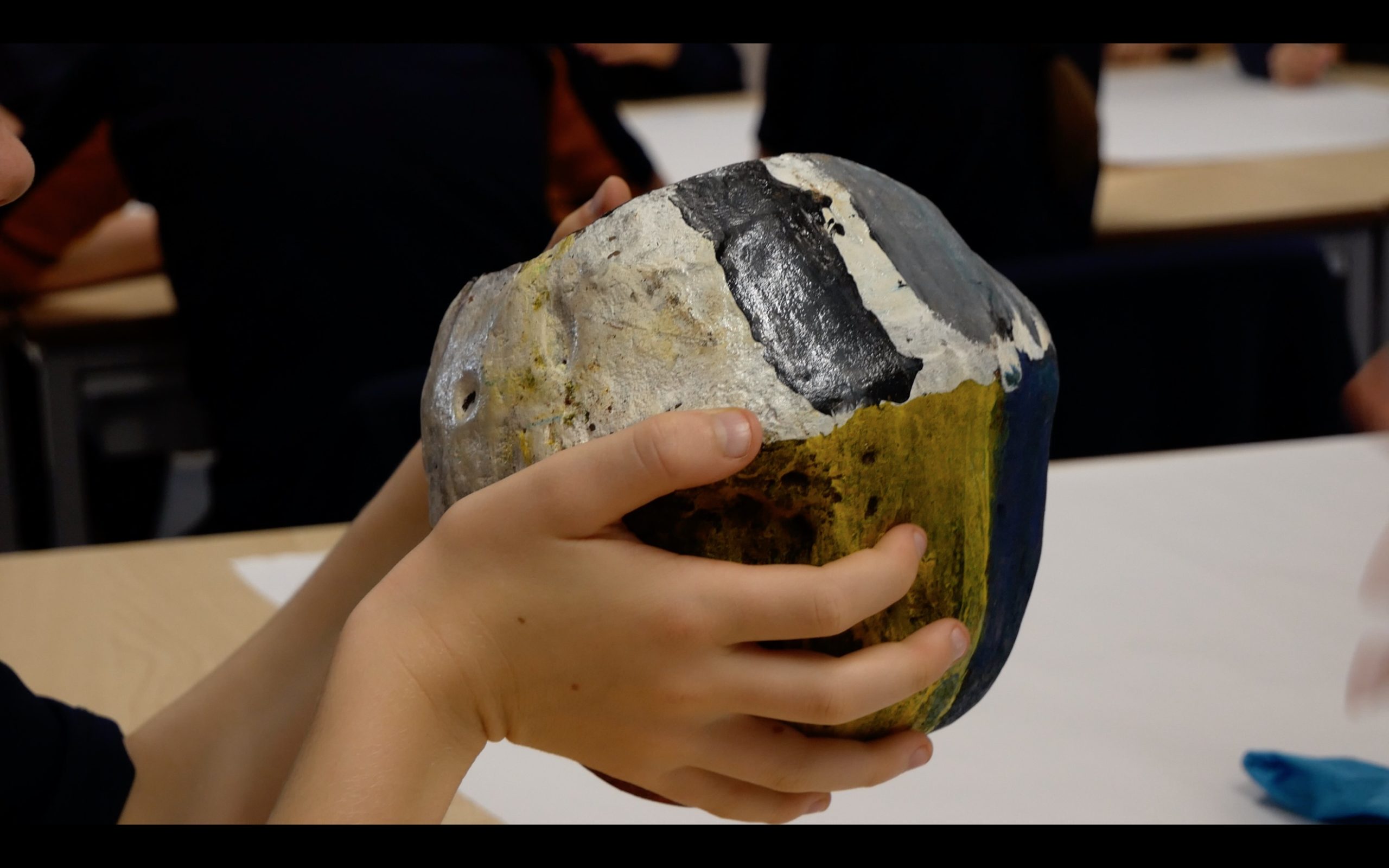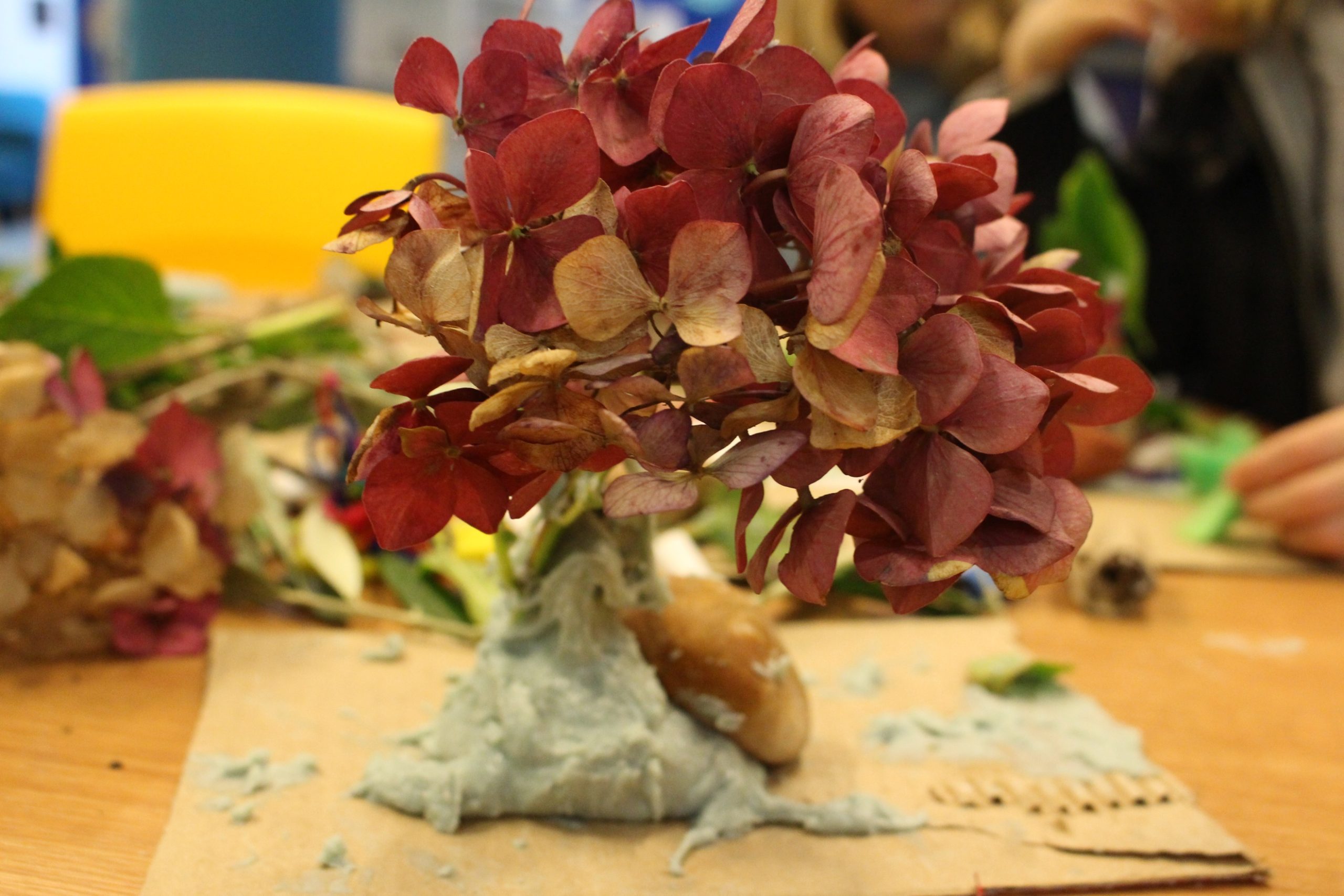Topic 2: My object, my story
 Brief Encounter
Brief Encounter
An object that matters to me and to the world . . .

In this photograph, a student in the United Kingdom is taking their time to handle, smell and speak about a pot made from the seed of the ‘Guayacán salero’ tree, which had been decorated by young people in Ecuador in ways that enhances its intrigue. The tree has strong associations with critically endangered Great Green Macaws.
-
Select an object that says something about what matters to you in relation to a sustainability topic.
- This could be to do with biodiversity loss, pandemics, climatic change, seasonality, resource scarcity, carbon emissions, energy, etc.
- Your object could be something found outside or something from your home (including things passed on through the years).
- If your chosen thing is too large or global, you can choose an image to convey the thing.
2. Tell others about your object and why it matters to you.
Thinking metaphorically using an image
Opportunities for Embracing Uncertainty
Wide ranging discussions can be prompted through objects that tap into students’ varied concerns, experiences and imaginaries about issues related to sustainability. This activity offers an opportunity to find out what it is that matters to them. Follow-up activities and input can respond to their concerns.
The choosing of the object prompts students to think about something valuable to them that could be threatened in an uncertain world and/or something that highlights their concerns about threats to the world or perhaps a love for something they want to be preserved for future generations.
Opportunities for All Students
The invitation to share an object is appropriate for students of all ages. Each will bring their unique and diverse knowledge, experiences and attachments.
Opportunities for Creativity
The choosing of objects is itself a creative endeavour as is the telling of the story of the object. Their story may change and build as they re-engage with their object, and as they share it with different audiences over time.
Students may choose something metaphorical or very literal.
They can be encouraged to ask questions of each other beyond the factual. For example, why is this so important to you? How would you feel if you lost it?
Opportunities for Linking to Climate Justice
Students may choose an object that is reflective of their cultural heritage or something that symbolises a connection with other parts of the world or family members present and past. The variety of objects collected offers an opportunity to discuss different experiences, values and cultural diversity.
If the school has links with those in other parts of the local area, across the country or another country, it might be possible to arrange to exchange objects that matter with others. This can provoke curiosity about the commonalities and differences of experiences and what matters. It would draw attention to different zones of experience and influence, requiring students to think about where they are connected to and how others are connected differently to their own zones. They could be invited to think about a web of connectedness within their own space as well as across other spaces.
 Deliberative Encounter
Deliberative Encounter
Creating something new from what matters to me

1. Take your chosen object and now change, adapt or embellish it to create something new.
- Choose which materials to use to do this. These might be human made things (e.g. tape, string, coloured bits of paper, material, stickers), natural materials (e.g. leaves, stones, sticks), and/or digital technologies (e.g. photography, animation, digital art).
2. Tell a story about what you have created. You might like to describe your thinking:
- Why did you create this?
- How did you create this?
- Why did you choose these materials or processes?
Creating something new to make deeper connections
Opportunities for Embracing Uncertainty
Through creating something new with their original object, students will begin to make further connections and possibly surface previously unacknowledged thoughts, feelings and ideas. These may relate to their own histories and experiences, as well as to wider social and political sustainability concerns. Students might engage with a range and complexity of feelings and thoughts, which may not be (and do not need to be) fully coherent. They might, instead, demonstrate the complexity and uncertainty of sustainability issues.
Opportunities for All Students
The hands-on creative and personal engagement can work with all students. They can adapt the activity to suit their interests, experience and knowledge. It may involve the telling of simple or complex stories.
Opportunities for Creativity
Students create something original from their chosen object, using their preferred media. There are possibilities to extend this activity in multiple ways, including filming, recording, and photographing the objects as well as the corresponding narrative. This draws attention to the aesthetic presentation in order to invite the engagement and comment of an audience.
Opportunities for Linking to Climate Justice
As with the previous activity, the opportunity to create something new can enable students to engage more with their cultural diversity and own histories. This might be transglobal or deeply situated in one location.
 Visual Encounter
Visual Encounter
Creating an exhibition
1. Make an exhibition of all the different artworks that your class have created about what matters to you. Consider these questions when curating your exhibition:
- Who is your audience? (e.g. families, friends, staff, governors, members of the local community, local decision makers, the local press)
- How will you curate all the artworks in your exhibition? What story do you want to tell with your artworks?
- What labels or other writing will you include and why? What message do you want to send?
- How can you share your exhibition with others? How will you advertise the exhibition?
2. Try to find a connection between your own object and another person’s object.
Create the story of how they are connected. This might be a made-up story, a shared experience or connection to something bigger.
3. Can you make a link between your exhibition and the different U.N. Global Sustainability Goals?
Might this be of interest to your audience?
Engaging the community with what matters
Opportunities for Embracing Uncertainty
Creating an exhibition requires students to consider further what it is that they want to communicate, and how might they best do so through the curation of their artworks. They must also negotiate how to do this together with their peers. Whilst students may have a clear message that they want to convey, the challenge for them is not to dictate a set meaning or to generate a moralising message (e.g. you must do this or that). It is easy to fall into the trap of simply telling people how they should think, feel or behave.
Opportunities for All Students
In primary schools, students can be offered the opportunity to design the exhibition using their whole classroom as a place for exhibits.
Some students will have wider relevant knowledge and experiences that will allow them to think in-depth about how to curate each work of art for the intended audience.
Opportunities for Creativity
The activity could be undertaken alongside a class visit to a public exhibition, which may prompt further discussion of how the students want to curate their artefacts and why.
Students may want to write their own labels and descriptions, which facilitates further thought about the power of language and storytelling. This will require decisions about what to include and leave out, in order to foster the creative interest of the audience.
Opportunities for Linking to Climate Justice
Students could draw on online research of global gallery exhibitions or their own experiences, to think about the design of their exhibition. They could describe their artworks using any language they prefer, as well as the primary language of instruction. This might strengthen connections to the students’ own heritage or the global sustainability issues addressed by their exhibits. By engaging with the UN Sustainability Development Goals, they are encouraged to think globally rather than simply locally.
 Beyond the Classroom Encounter
Beyond the Classroom Encounter
Exhibiting what matters

1. Think about who you have invited to your exhibition.
- How will you welcome and speak with your visitors when they come to the exhibition? What do you want to ask and tell them?
2. How will you invite your audience to discuss what the artworks mean to them? For example, you might ask:
- What do you see?
- What do you think?
- What do you feel?
- What might you do differently?
Being open to a diversity of community perspectives
Opportunities for Embracing Uncertainty
Having created an exhibition, the students can now consider how to engage the audience more deeply with their artworks.
The challenge will be to remain uncertain and open to hearing how the audience responds, without being too sure about how they should respond. It requires them to be open to listening to things that they may not agree with, things they have not thought about themselves, or to responses that are highly unexpected. Are they open to having their own perspectives change by listening to others?
Opportunities for All Students
It may be useful for some groups to send a preview of the work being displayed for a discussion at home before parents/carers visit the classroom gallery. This gives each student the chance to share their object and meaning of it with their family in a more intimate environment. The activity offers all students the opportunity to engage in discussion with their community but some more than others will take up the opportunity both to listen and to deliberate with others.
Opportunities for Creativity
After the exhibition, the students could be encouraged to reflect on the impact that their artworks and their curation had on the audience, as well as on themselves. How did they feel? What was most powerful? How did others engage? What surprised them? Would they change anything next time?
Opportunities for Linking to Climate Justice
The exhibition creates an opportunity for families, carers, friends, and potentially local professionals with relevant expertise and local decision makers, as well as others from diverse backgrounds, to engage with and to respond to the students’ concerns through their exhibition. By inviting the response of the audience, and being open to a range of responses, the exhibit signals an embracing of the diversity of the community. The purpose is not to instruct but to inform and to engage with multiple challenges and perspectives.

